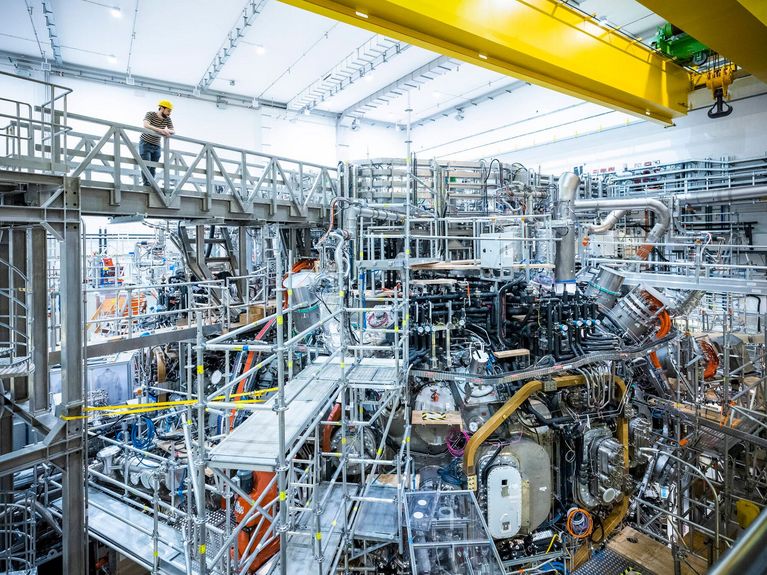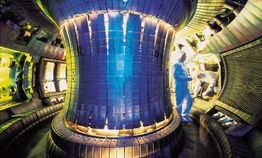
Story #12
Our Mission: To Produce Energy Just Like the Sun
Nuclear fusion is the only climate-neutral energy source not yet tapped by humanity. The large-scale experiment Wendelstein 7-X in Greifswald is designed to pave the way for a fusion power plant. The facility, the highest-performing of its kind, is the product of close collaboration between Helmholtz and Max-Planck.
When it comes to the future energy supply, we’ve chosen an ambitious role model: the sun. Without the sun, there would be no life on Earth. The energy it emits in the form of light and heat is produced by nuclear fusion – the fusing of nuclei within million-degree-hot plasma. Researchers are attempting to reproduce the process here on Earth, using a number of strategies. The most advanced and highest-performing facility in the world, a stellarator, is operated by the Max Planck Institute for Plasma Physics (IPP): Wendelstein 7-X. The IPP was a member of the Helmholtz Association until 2021 and remains an associated scientific partner.
The facility in Greifswald traps a million-degree-hot gas – or plasma – within a ring-shaped magnetic field, so that it floats in a donut-shaped vacuum chamber virtually contact-free.
Construction of the highly complex facility was coordinated by the IPP, together with industrial firms and research institutes from across Europe, including two Helmholtz Centers: Karlsruhe Institute of Technology (KIT) and Forschungszentrum Jülich. First installed in 2015, it resumed operations after an extensive expansion phase in 2022.
Wendelstein 7-X is composed of five nearly identical modules, which were installed prefabricated in a ring formation in the testing hall. 70 superconducting coils, which wind around a steel plasma vessel, are enclosed within the ring-shaped outer hull. Inside, where the air has been pumped out to create a vacuum, the magnetic coils are cooled to superconducting temperature (near absolute zero) using liquid helium – which means that, once activated, they require very little energy. 50 of these coils, which can be up to 3.5 meters tall and weigh up to 6 metric tons each, are not planar but non-planar.
In addition to these main components, kilometers of cooling pipes, electrical and monitoring cables, numerous monitoring posts and sensors had to be installed, a process accompanied by regular inspections and integrity tests for the structure’s several thousand welded joints.
Without intensive collaboration between the participating research centers, a project of this magnitude would hardly have been possible. In this regard, each center contributed unique expertise: for example, KIT assumed responsibility for constructing the vital plasma heating system – the Electron Cyclotron Resonance Heating (ECRH) system – which it continues to refine today. In 2024, the world’s highest-performing module of its kind was brought online: the Gyrotron, built by the Thales company, is capable of generating more than one Megawatt of output in the plasma through microwaves. In addition, KIT developed and manufactured the power leads for the coil circuits, which connect the normally conducting power supply to the superconducting coils. By using high-temperature superconductors, it was possible to install these innovative leads compactly underneath the stellarator – and therefore against the direction of normal thermal convection, with the warm end below and cold end above.
In turn, Forschungszentrum Jülich developed the superconducting conduits for Wendelstein 7-X’s magnetic coils. This spiderweb-like system has to withstand powerful forces within the magnetic field, which necessitates its highly complex geometric form. Forschungszentrum Jülich also collaborated with the Belgian research institute ERM/KMS to design the Ion Cyclotron Resonance Heating (ICRH) system for Wendelstein 7-X.
What’s more, Jülich developed new instruments for measuring plasma properties, including
- HEXOS, a spectrometer for the ultraviolet range, which can detect impurities in the plasma,
- an endoscopic spectrometer for assessing plasma-wall interactions, and
- a Multipurpose Manipulator, which can insert its probes into the hot plasma for fractions of a second.
Picture: Jan Hosan
Participating centers
The Max Planck Institute for Plasma Physics (IPP) in Garching concentrates on nuclear fusion research. Its goal is to emulate on Earth the way the Sun generates energy.
